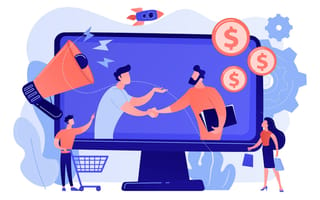Alex Tumarinson knows what he’s looking for in a sales pitch.
Having managed tech teams since 2009, Tumarinson, who is now Endpoint’s head of growth, has participated in hundreds of software pitches and purchasing decisions. When he gets on the phone with a salesperson to discuss a product, he’s already read the ratings on TrustPilot, compared similar products and looked into the support documentation.
“But I only need 20 minutes to see your platform and ask a few questions to get a sense of what it does. That’s all I need to make a decision.”
It may seem like a done deal, but the salesperson still plays a crucial role in his decision-making. At that point in his buying process, it’s up to the salesperson to show him how his team can make the most out of the product.
“I understand that sales reps do need time to understand what your needs are, so I respect that and I will give them that time,” Tumarinson said. “But I only need 20 minutes to see your platform and ask a few questions to get a sense of what it does. That’s all I need to make a decision.”
Every buyer has different priorities and procurement processes, so paying attention to the clues they drop and knowing where they are in the buying journey can go a long way in securing a deal. A bad sales experience, like failing to reach out to a buyer after they downloaded a demo, or not responding to their frequent inquiries about the product, can tank a deal. And a technically flawless pitch can fail if the solutions presented don’t align with the buyer’s needs.
For salespeople, it can be difficult to know exactly what the buyer wants. So, we spoke with Tumarinson and PaymentCloud CEO Shawn Silver about how they approach buying software, and what they look for during each phase of the process.
3 Tips From the Buyers
- Make sure the discovery process is tailored to the customer. Understanding what the customer wants to learn can help tailor the discovery conversation.
- Introduce product use-cases that are relevant to the buyer. When a salesperson shows Tumarinson ways other businesses in his industry use their product, he's more likely to purchase the product.
- A smooth onboarding experience can help turn a customer into a long-term user.

Tailor the Discovery to the Buyer
Tumarinson’s buying journey starts when his team identifies a problem within its workflow.
As head of growth at Endpoint, which provides a title and escrow platform for real estate agents, Tumarinson works with marketing, sales and data teams. Their issues could range from needing to merge a data set to automating manual data entry. Whatever the need, he prefers to survey the product landscape and research tools for himself.
“I want to jump into the interface as much as possible. I want to see the back end, I want to see the portal and some examples of how things are set up.”
During his research, he’ll prioritize how a product integrates with his company’s current tech stack, pricing and feature complexity. By the time he reaches out to a salesperson, he doesn’t need the spiel — he wants to see the product in action.
“I want to jump into the interface as much as possible,” Tumarinson said. “I want to see the back end, I want to see the portal and some examples of how things are set up. It’s extremely educational for me if you can show me how another fintech company or real estate company set up a campaign.”
At PaymentCloud, which offers a payment processing service, Silver prefers to use the first call as a fact-finding mission. He’s looking for the salesperson to be prepared to answer questions, like how the product would work for his company, the value it would provide for his team and the price points.
Of course, that process gets sped up if it’s a cold call. In those situations, Silver gives a sales rep three minutes to convince him that their company’s product is relevant to his company and can help them. If they can, then he’ll move the conversation forward to the next stages.
“We want to see more about what they can offer us, and then we can have some offline talks about what we can use,” Silver said.
While they both may have a notion of the product at this stage, a salesperson’s actions can still make or break the deal. Both Tumarinson and Silver stressed the importance of a personalized pitch at this stage. In fact, one of Tumarinson’s biggest frustrations is when the discovery call starts too broad and the salesperson requires multiple meetings before they start digging into the details of the product.
If he knows what he wants out of a product, he’ll send them exactly what he’s looking for. Still, they don’t always take that into account.
“I give them as much information as possible to at least get a very tailored and personalized interview, but what usually ends up happening is I have to re-emphasize my needs and questions for at least 30 minutes to an hour,” Tumarinson said.
Relevant Use-Cases Can Help Seal the Deal
Once Tumarinson gets to the product demo, he’s looking for an aha! moment.
At this point, he’s already played around with the product on his own or watched videos of how it’s been used. This is the part where he needs a salesperson to show him how he can make the most of the product’s capabilities, and that means examples of how similar companies have used it.
“Whenever I see something I would never have thought of and I’m like, ‘That’s genius,’ it increases the chances of converting me.”
He wants to know how his competitors have integrated it into their existing tech stacks, and how they’ve extracted value from it or applied it to positive results.
“Just show me how things are configured. I can immediately identify if that can be effective to us,” Tumarinson said. “Whenever I see something I would never have thought of and I’m like, ‘That’s genius,’ it increases the chances of converting me.”
The worst thing a salesperson can do is to show him examples of how an unrelated company found success using the product — especially if it’s already covered in ad magazines.
“I can’t really do anything with that,” Tumarinson said. “That’s cool that they used you, but don’t spend 20 minutes on this.”

Procuring the Software
Throughout the buying process, Tumarinson usually brings in any team leaders who would use the tool to gather their opinions.
Since his company has an agile approach to buying products, he doesn’t need to convince the CEO or gather a long list of signatures to make a purchasing decision. Instead, he works with team leaders to evaluate how much their teams will use the product.
The more use-cases a salesperson can provide and the more detailed the onboarding process is, the better. It can be frustrating to adopt a product that you only partially know how to use, he said.
“You might never learn how to use that particular feature that could have provided so much value and efficiency to you, but it was buried or you never even knew it existed,” Tumarinson said.
Silver’s team goes through a similar process. If it’s a larger adoption, like procuring Slack, he’ll incorporate managers on each team into the buying journey. From there, they’ll evaluate the product with demos and determine whether it’s a tool that’s useful for a short period of time or will be ingrained into the permanent tech stack.
“It’s in the company’s best interest to invest a month into making you successful because that means you’re going to be their client for many years to come.”
At this point, the more a salesperson can be available to answer questions, show demos and provide business metrics, the more likely he is to close a deal.
“Slack had various demos and emails going back-and-forth,” Silver said. “They even sent us videos of what other companies were doing and talked about the integration we can do from our CRM. They got more creative about the possibilities of what could be done on it.”
When it comes down to it, Tumarinson may know what he wants out of product, but it’s up to the salesperson to show him how to use it.
“It’s in the company’s best interest to invest a month into making you successful because that means you’re going to be their client for many years to come,” Tumarinson said.




